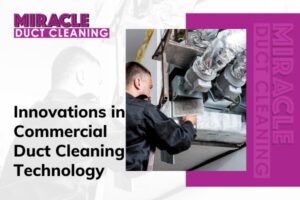
Commercial air duct cleaning is an integral process toward the attainment of good indoor air quality, maximizing the efficiency of HVAC, and generally promoting a healthy environment for employees and customers. It is the years that have continuously reformed the business of commercial duct cleaning, leapfrogging the aid of technological advancement to make the process much more effective, efficient, and friendly to the environment.
In this blog, we will read about some of the newest innovations in commercial duct cleaning technology that are changing the way we maintain our air systems.
1. High-Resolution Inspection Cameras
One of the most important advancements made in duct cleaning technology would be the use of high-resolution video inspection equipment. These cameras have been designed to integrate within the ductwork and show distinct real-time videos of the interior surfaces. This allows technicians to identify areas with heavy dust buildup, mold growth, or debris and to inspect the general condition of the ducts. High-resolution cameras allow for a more accurate cleaning by targeting problem areas and thus making sure no section goes unnoticed.
2. Robotic Cleaning Systems
Robotic cleaning systems are changing the face of duct cleaning. Equipped with brushes, vacuums, and cameras, they can self-navigate through complex ductwork. A robotic cleaner can access those places which, at times, even human technicians find hard to reach. They scrub and vacuum simultaneously to ensure proper cleaning, sucking out all contaminants. Besides, it is possible to control robotic systems remotely, and this enables technicians to monitor the process of cleaning and make adjustments where necessary.
3. HEPA-Filtered Vacuum Systems
High-efficiency particulate Air filters capture at least 99.97% of particles as small as 0.3 microns. Modern duct cleaning equipment usually contains HEPA-filtered vacuum systems, which work extremely well during the cleaning process at trapping fine dust, pollen, mold spores, and other debris. This, therefore, substantiates that the air released back into the building, because of HEPA filtering, is particle-free and helps enhance indoor air quality.
4. Air Whip Cleaning Tools
Air whip duct cleaning equipment uses compressed air projected through a flexible rod with whips at the ends spinning at high speed. They create a powerful stream of air, maximizing its potential to loosen dust and other debris from interior surfaces in the ductwork. The air whips offer immense ability to remove stubborn contaminants, ensuring the cleanliness of the ducts, especially those with odd shapes or sharp corners. The dislodged debris is then vacuumed out, leaving the ducts clean and clear.
5. Antimicrobial Treatments
Some commercial duct cleaning services offer antimicrobial treatments after the physical cleaning process. These involve coating the inside of ducts with antimicrobial agents, which inhibit mold, bacteria, and other types of microbiological growth. Antimicrobial treatments provide an enormously cleaner environment inside the ductwork and may further elongate the time before the next required cleaning for a long-term improvement in air quality.
6. UV-C Light Technology
Ultraviolet light technology, UV-C, is an exciting solution to keep the ducts clean. In this technology, the installation of UV-C lights is made within an HVAC system and will emit UV light designed to kill or deactivate microorganisms like bacteria, viruses, mold spores, and other microbiological contaminants while they pass through the ducts. This sanitizes the air continuously when it circulates throughout the building, giving an extra line of defense against airborne contaminants.
7. Advanced Airflow Measurement And Monitoring
Modern duct cleaning technology includes advanced airflow measurement and monitoring equipment to measure the efficiency of the HVAC system before and after cleaning. The measurement of airflow rates, pressure differentials, and system performance will provide data to help technicians fine-tune the cleaning process. Therefore, better measurement of the airflows assures that the cleaning process produces a measurable improvement in terms of efficiency and general performance of the HVAC.
Advancements in commercial duct cleaning technology have not only improved the effectiveness and efficiency but also its environmental impact on the cleaning process. From high-resolution inspection cameras and robotic cleaning systems to HEPA-filtered vacuums and UV-C light technology, these innovations are greatly helping businesses keep their indoor environments clean and healthy.
Further improvements in duct cleaning techniques will come with improved technology, hence improving the quality of air in commercial buildings and contributing towards the well-being of the employees and customers. Contact us for more.
